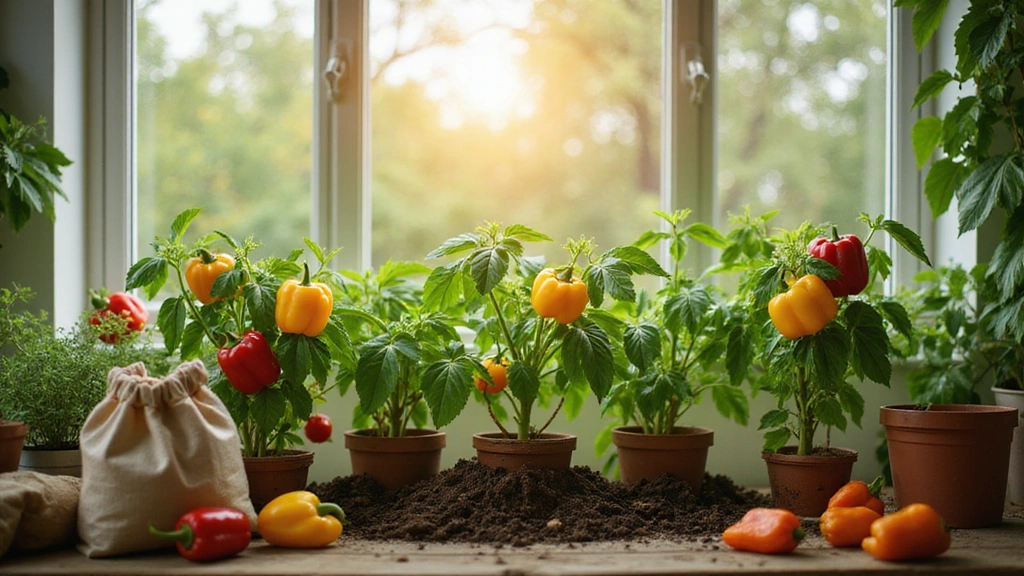Welcome to your ultimate guide for cultivating vibrant bell peppers right in your home!
Imagine plucking fresh, crisp peppers from your indoor garden, adding a burst of color and flavor to your meals.
This article will take you through essential tips and tricks for indoor gardening, ensuring your bell pepper plants thrive in their cozy indoor environment. Get ready to transform your space into a lush green haven filled with the sweet aroma of homegrown peppers!
Contents
- Choosing the Right Variety
- Optimal Growing Conditions
- Soil Selection and Preparation
- Planting Your Bell Peppers
- Watering Techniques
- Fertilizing Your Plants
- Supporting Your Plants
- Pest Control Strategies
- Understanding Pollination
- Harvesting Your Bell Peppers
- Storing Your Harvest
- Troubleshooting Common Issues
- Enjoying the Fruits of Your Labor
- Personalizing Your Indoor Garden
Choosing the Right Variety

When embarking on the journey of growing bell peppers indoors, the choice of variety plays a crucial role in determining your success.
Popular options such as California Wonder and Mini Bell are excellent selections due to their compact growth habits and impressive yields.
These varieties thrive in indoor environments, producing sweet, juicy peppers that are ideal for snacking or enhancing your favorite recipes.
To kickstart your gardening adventure, consider using seed starting trays for optimal germination and growth, along with organic fertilizer to nourish your plants for a bountiful harvest. Look for seeds specifically labeled for indoor gardening to ensure the best results!
Optimal Growing Conditions

Bell peppers flourish in warm environments, making it essential to establish the perfect indoor conditions for your plants.
To ensure they thrive, provide your bell peppers with a daily light exposure of 12 to 16 hours. If natural sunlight is insufficient, consider investing in LED grow lights to supplement their light needs.
Maintaining a consistent temperature between 70-85°F (21-29°C) is crucial, along with humidity levels around 50-70% for optimal growth. A humidity meter can help you monitor these conditions effectively.
Additionally, proper airflow is vital to ward off mold and pest problems. To enhance air circulation around your plants, consider using a small oscillating fan. Lastly, keeping track of your indoor climate is easier with an indoor thermometer, ensuring your bell peppers grow in an optimal environment.
Soil Selection and Preparation

Choosing the right soil is crucial for achieving success in your indoor gardening endeavors.
Select a premium organic potting mix that offers excellent drainage while still retaining moisture—this balance is essential for ensuring your bell peppers receive the nutrients they need without becoming waterlogged. You can enhance your soil by incorporating perlite or vermiculite, both of which improve aeration and drainage, allowing the plant roots to flourish.
Additionally, consider using a soil moisture meter to monitor the moisture levels in your potting mix, providing you with valuable insights to maintain optimal growing conditions. Remember to steer clear of garden soil, as it may carry pests and diseases that can hinder your plants’ growth.
Planting Your Bell Peppers

Planting bell pepper seeds or seedlings marks an exciting milestone in your indoor gardening adventure.
Begin by filling your pots with high-quality prepared soil, ensuring that you use planting pots with drainage to promote healthy root growth and prevent waterlogging.
When planting, place the seeds about ¼ inch deep, or if you’re transplanting seedlings, do so with care to keep the root ball intact. After planting, gently water the soil thoroughly using a watering can with a fine spout to avoid disturbing the seeds or seedlings.
Don’t forget to label your pots with seedling labels to easily keep track of the different varieties. Lastly, protect your hands while working by wearing garden gloves, ensuring a safe and enjoyable planting experience!
Watering Techniques
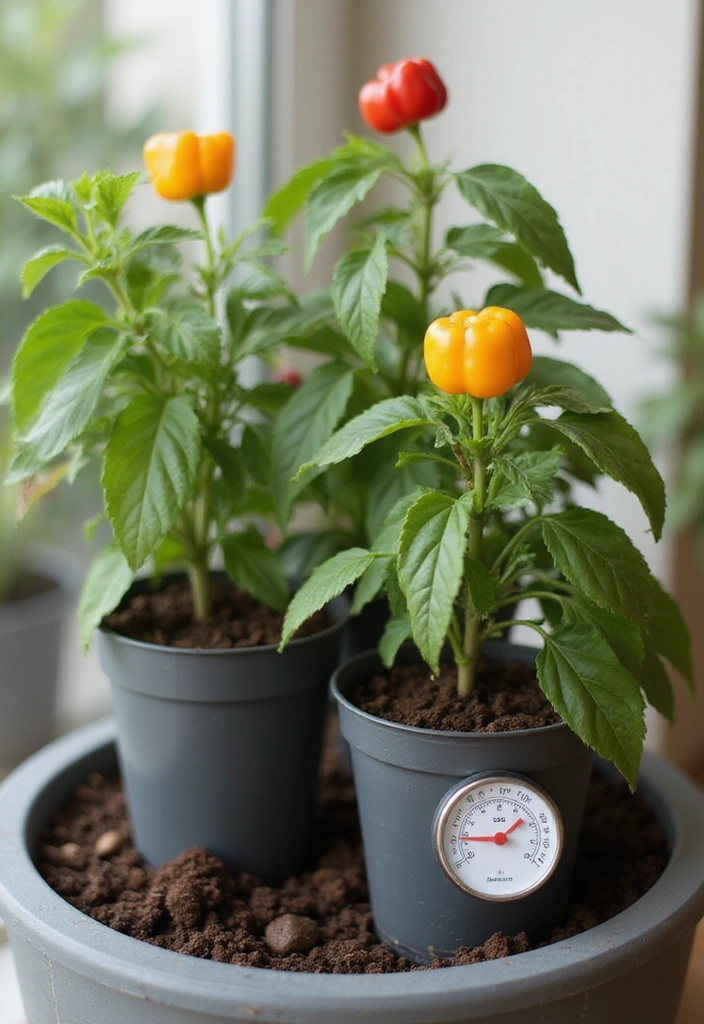
Watering is an essential element in the care of your indoor bell peppers.
To ensure your plants thrive, aim to keep the soil consistently moist but avoid waterlogging, as overwatering can lead to root rot. A practical approach is to check the top inch of the soil; when it feels dry to the touch, it’s time to water.
You might want to consider investing in self-watering pots, which can help regulate moisture levels and reduce the frequency of watering. Additionally, using a moisture meter can provide accurate readings of your soil’s moisture content, ensuring your bell peppers receive the right amount of hydration.
Don’t forget to have a reliable watering can on hand to make the process easier and more efficient! Keeping these tools in mind will help you maintain healthy and vibrant plants.
Fertilizing Your Plants

To ensure your bell peppers thrive and produce an abundance of fruit, proper fertilization is crucial.
Applying a balanced, water-soluble fertilizer every 4-6 weeks during the growing season will significantly enhance their growth. Look for a fertilizer with an NPK ratio of 5-10-10, as this specific formulation is designed to promote blooming and fruiting. You can find an excellent option for this purpose here: water-soluble fertilizer.
When measuring out your fertilizer, it’s important to use the correct dilution rates to avoid over-fertilization, which can be detrimental to your plants. A reliable set of measuring spoons will help you achieve the right measurements.
For those who want to streamline the fertilization process, consider using a fertilizer injector to effortlessly deliver nutrients to your plants. Lastly, don’t forget to protect your hands while gardening; a good pair of gardening gloves will keep them safe and clean as you tend to your bell pepper plants.
Supporting Your Plants

As your bell pepper plants grow, providing them with adequate support is essential to prevent the branches from breaking under the weight of the fruit.
Utilizing tomato cages or stakes can significantly enhance stability, particularly for larger bell pepper varieties.
Be sure to gently tie the stems with soft garden ties to protect the delicate plants from damage.
This additional support helps ensure that your bell peppers can thrive and reach their full potential, all while minimizing the risk of branches falling or breaking. For any necessary trimming, don’t forget to keep a pair of reliable pruning shears on hand to maintain the health of your plants.
Pest Control Strategies
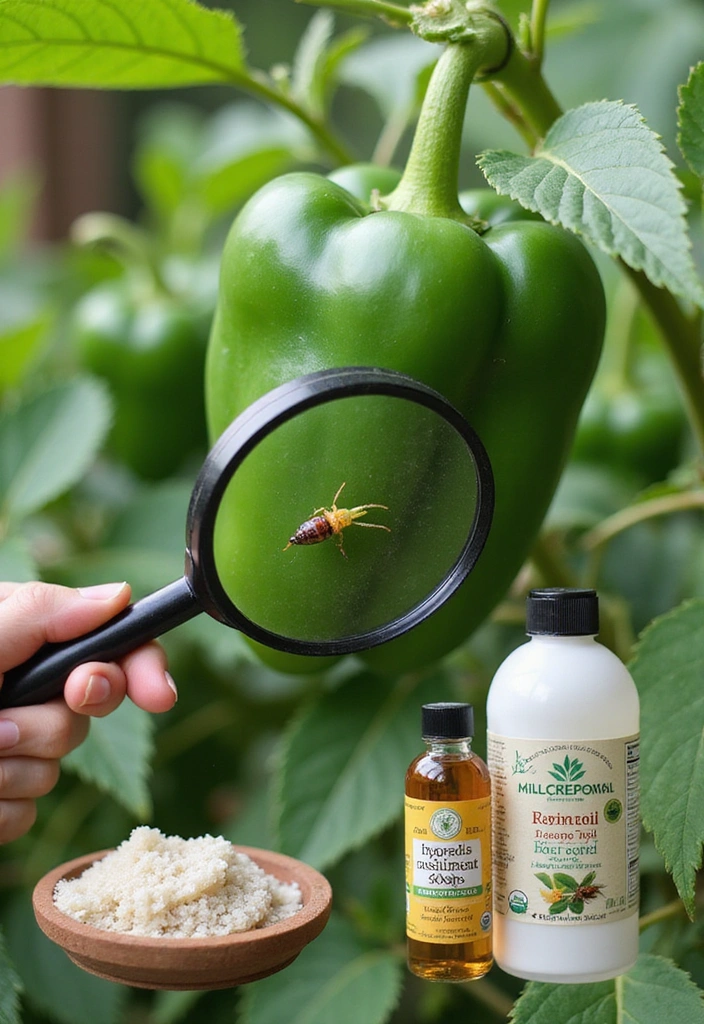
Keeping your indoor garden free from pests is essential for the overall health and vitality of your bell peppers. Regularly inspect your plants for any signs of common pests, such as aphids or spider mites, which can quickly become detrimental to your crops.
To effectively manage these infestations, consider using natural remedies like neem oil or insecticidal soap. Both options are safe for your plants and can help control pest populations without causing harm.
Additionally, maintaining good airflow around your plants and avoiding overcrowding can significantly reduce the risk of pest problems. You might also want to utilize pest control traps to monitor and capture any unwanted visitors, ensuring your indoor garden remains thriving and healthy.
Understanding Pollination
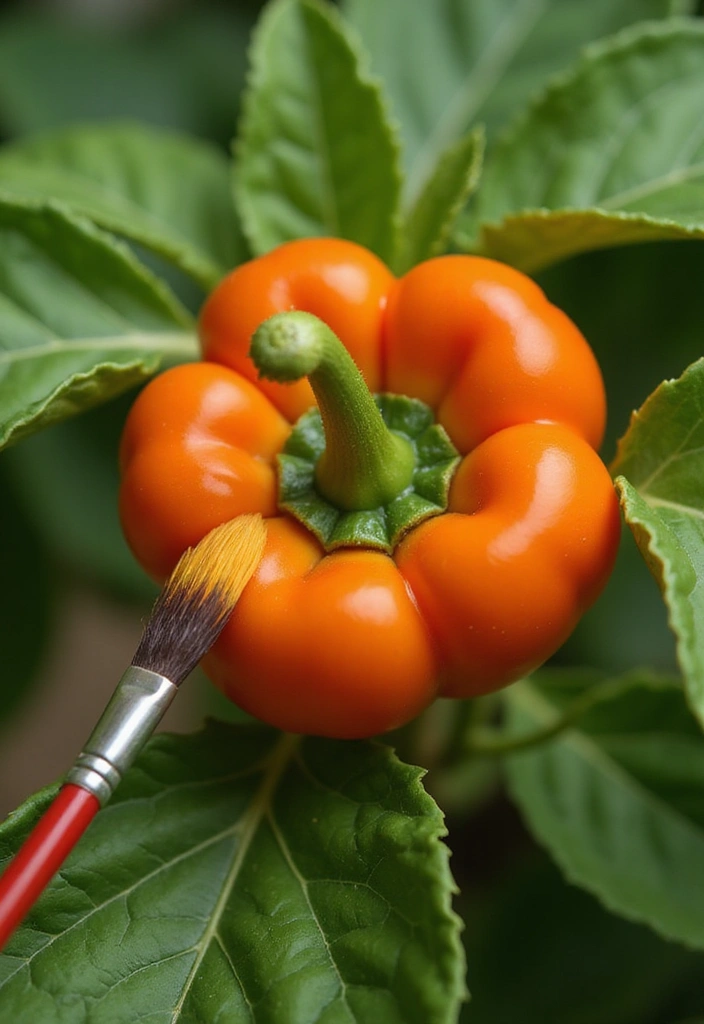
Bell peppers need effective pollination to yield fruit, and when grown indoors, they often require some assistance in this process.
To enhance pollination rates, you can gently shake the plants or utilize a small artisan paintbrush set to transfer pollen between flowers.
Additionally, attracting beneficial insects like bees can significantly aid in pollination. Consider planting bee-attracting flowers nearby to create a welcoming environment for these pollinators.
Using a fan to mimic natural wind can also be effective, helping to ensure that your bell pepper plants have the best chance for a bountiful harvest. For more detailed information, you might find a pollination guide helpful in maximizing your indoor gardening success.
Harvesting Your Bell Peppers

The moment you’ve been eagerly anticipating has arrived—it’s time to harvest your bell peppers!
Before you proceed, ensure that the peppers have reached their full size and vibrant color, which can range from green to yellow or red, depending on the specific variety you’re growing.
When it’s time to pick, grab a pair of sharp scissors or pruning shears to carefully cut the peppers from the plant, making sure to leave a small stem attached. This gentle harvesting technique not only promotes further growth but also helps maintain the overall health of your plants.
To make the process even smoother, consider using a harvest basket to collect your freshly picked peppers. A gardening apron can also be a handy tool, allowing you to keep your tools and any additional supplies close at hand. Finally, once you’ve harvested, store your bell peppers in vegetable storage bags to keep them fresh for longer. Happy harvesting!
Storing Your Harvest
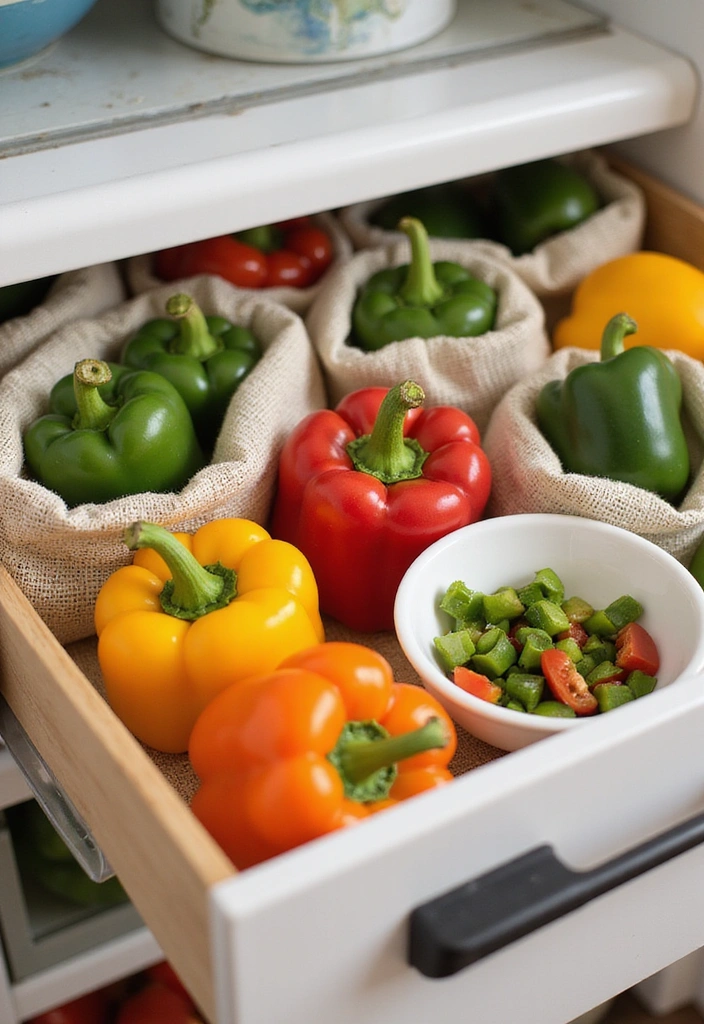
Once you’ve harvested your bell peppers, proper storage is crucial to preserve their crispness and flavor.
To keep them fresh, store your peppers in a breathable bag within the refrigerator’s crisper drawer, where they can maintain their quality for up to two weeks. For those who want to enjoy their homegrown peppers even longer, freezing is an excellent option. Slice your peppers and blanch them before placing them in freezer bags.
Additionally, using vegetable crisper containers can help organize your refrigerator and keep your produce fresh for an extended period. Don’t forget to have a sturdy cutting board on hand for slicing your peppers before freezing. This way, you can savor the delightful flavors of your indoor garden throughout the off-season!
Troubleshooting Common Issues
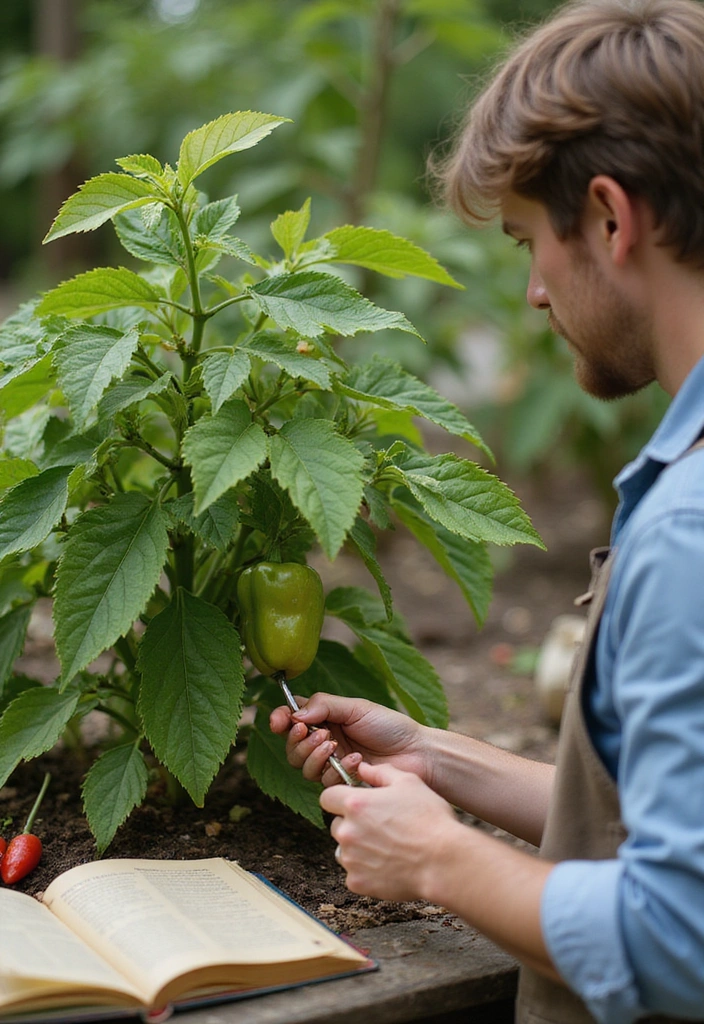
As with any gardening endeavor, challenges can arise when growing bell peppers indoors.
Common issues such as yellowing leaves, stunted growth, or blossom drop can be frustrating. To effectively identify these problems, it’s essential to observe your plants closely. Overwatering, nutrient deficiencies, or inadequate light may be the culprits.
Investing in a good gardening reference book can provide you with valuable insights into the specific needs of bell peppers. Additionally, a comprehensive plant care guide can offer targeted advice on how to rectify issues like nutrient deficiencies or light requirements.
Furthermore, using a pH meter can help you monitor soil conditions, ensuring your plants receive the ideal environment for growth. By addressing these issues promptly and utilizing the right resources, you can significantly enhance your indoor gardening success.
Enjoying the Fruits of Your Labor

The final step in your indoor gardening journey is to truly enjoy the fruits of your labor!
Incorporate your homegrown bell peppers into a variety of delicious dishes, ranging from fresh salads to vibrant stir-fries and zesty homemade salsas. To serve your creations in style, consider using a beautiful salad bowl set that showcases the colorful peppers and other ingredients.
A sharp chef’s knife will make chopping and preparing your fresh produce a breeze, ensuring you can whip up your favorite recipes with ease. For even more inspiration, explore a range of recipe books that will help you maximize the use of your homegrown bounty.
Don’t forget to store any leftovers in handy meal prep containers to keep them fresh for future meals. Share your delightful creations with family and friends, and take a moment to celebrate your indoor gardening success!
Personalizing Your Indoor Garden
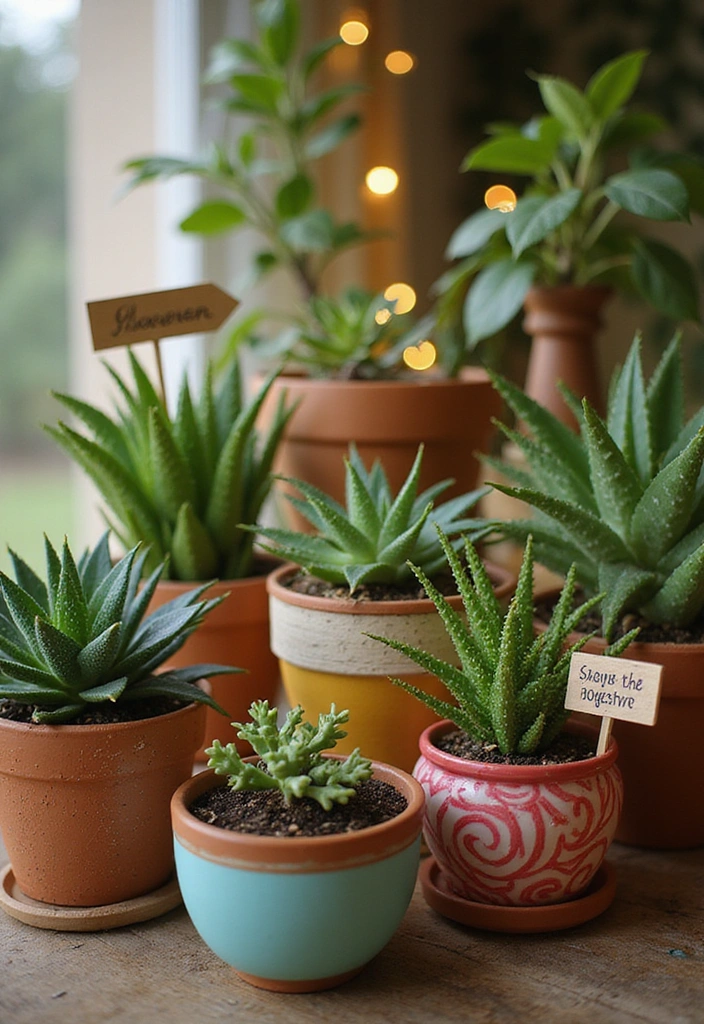
Creating a personalized indoor garden not only enhances your gardening experience but also allows you to express your unique style.
Consider using decorative plant pots that complement your interior decor and reflect your personality.
Labels, such as plant labels, can help you keep track of your bell pepper varieties while adding a touch of charm to your garden setup.
Additionally, incorporating indoor garden decor like fairy lights or botanical prints can transform your gardening space into a cozy retreat, making it a delightful environment to nurture your plants.
Conclusion

Growing bell peppers indoors can be a rewarding and enriching experience, bringing joy and fresh produce right to your kitchen.
By following these tips and tricks, you can cultivate a successful indoor garden that flourishes with vibrant peppers.
Don’t hesitate to share your gardening journey and connect with fellow enthusiasts who share your passion for indoor gardening!
Note: We aim to provide accurate product links, but some may occasionally expire or become unavailable. If this happens, please search directly on Amazon for the product or a suitable alternative.
This post contains Amazon affiliate links, meaning I may earn a small commission if you purchase through my links, at no extra cost to you.

